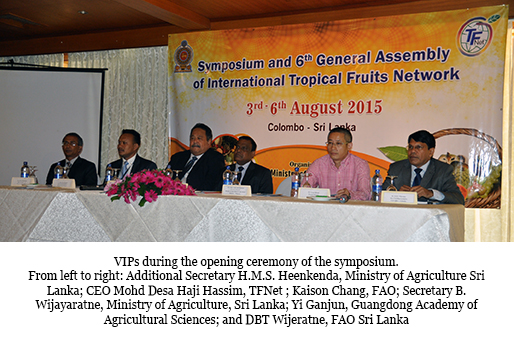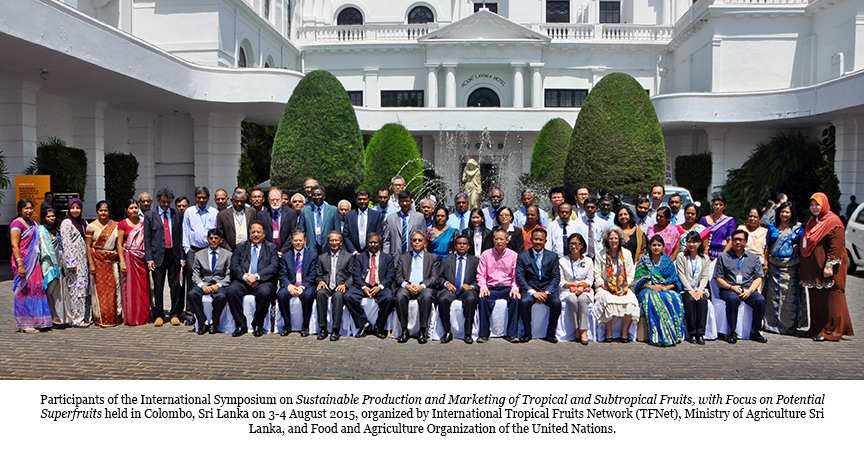The International Symposium on “Sustainable Production and Marketing of Tropical and Subtropical Fruits with Focus on Potential Superfruits” was held in Sri Lanka on 3-4 August 2015, jointly organized by the International Tropical Fruits Network (TFNet), Ministry of Agriculture Sri Lanka, Food and Agriculture Organization of the United Nations (FAO), and the Centre on Integrated Rural Development for Asia and Pacific.
As a follow-up to the “International Symposium on Superfruits: Myth or Truth?” held in Vietnam on July 2013, the Symposium aimed to identify tropical and subtropical fruits with the potential to be labelled as superfruits based on their nutritional and phenolic contents.
Participants also discussed consumer demand and strategies to promote and market tropical and subtropical fruits, shared the latest research and developments in production and postharvest, and deliberated on government policies that can improve the industry.
Sixty-five participants from 15 countries attended the symposium, including Australia, Sudan, Fiji, Korea, Thailand, Malaysia, Japan, Thailand, India, and Germany. The attendees represented international organizations, government agencies, academic and research institutions, and also the private sector.
 The opening ceremony was officiated by His Excellency B. Wijayaratne, Secretary of the Sri Lankan Ministry of Agriculture.
The opening ceremony was officiated by His Excellency B. Wijayaratne, Secretary of the Sri Lankan Ministry of Agriculture.
“Fruit cultivation is helpful for increasing the income of the farmer community,” said Wijayaratne. He added that fruit production “provides the people with nutritious food towards a healthy lifestyle.” Although the per capita fruit consumption in Sri Lanka is still low, he said that the industry is “quickly catching up to accommodate a diverse range of over 200 edible fruit species.”
Wijayaratne also stressed the importance of the symposium in creating an opportunity for stakeholders to “exchange experiences and knowledge, forming an attractive method for changing the fruit agricultural landscape of the next decade.”
Other notable VIPs in the opening ceremony were Kaison Chang, Secretary of the Intergovernmental Group on Bananas and Tropical Fruits, FAO; His Excellency Azmi Zainuddin, High Commissioner of Malaysia in Sri Lanka; His Excellency Wassfi Hassan Nawwaf El-Sreihin, Secretary General of the African Asian Rural Development Organization (AARDO); Yi Ganjun, Vice Chairperson of TFNet and Vice President of Guangdong Academy of Agricultural Sciences, China; and Dr. Hassan M. Ali Dinar, FAO Kingdom of Saudi Arabia.
Paper Presentations
Fifteen oral presentations were delivered during two sessions: Production, Marketing, and Trade of Tropical Superfruits and Nutritional Benefits of Potential Superfruits.
A short summary of each presentation are as follows:
(Click the title to download the presentation slides)
Keynote paper
Dr. Yi Ganjun
Vice President, Guangdong Academy of Agricultural Sciences, China
Fusarium Wilt, caused by soil-borned fungus Fusarium oxysporum f. sp. cubense (Foc), is probably the most dangerous banana disease in history. It destroyed almost all plantations of the Gros Michel banana variety in the 1950s, forcing the industry to plant resistant cultivated varieties of Cavendish. However, new strains of Foc (collectively known as Foc Tropical Race 4) has killed thousands of infected Cavendish plants. In this presentation, Yi Ganjun suggests a three-fold approach to help prevent another global agricultural epidemic.
Session 1: Production, Marketing, and Trade of Tropical Superfruits
1. Exotic Superfruits – consumer trends in Europe between health and hype
Dr. Hannah Jaenicke
Horticulture Competence Centre, University of Bonn, Germany
After a rapid rise in the market share, “superfruits” such as pomegranate, mangosteen, acai, acerola, and gojiberry seem to have been demystified. In this presentation, Dr. Hannah explains the recent claims that of European consumer support groups that the health effects of these exotics are no higher than that of several local fruits and could even lead to health risks. Thus, European consumers have slowly been focusing on locally grown produce.
2. Consumer and import trends of potential tropical superfruits in Korea
Dr. Rhee Juhee
Rural Development Administration, Republic of Korea
The majority of fruits grown and consumed in Korea are temperate: apples, grapes, pears, peaches, citrus, and persimmons. Other than banana, mango, and pineapple, most tropical fruits are relatively unknown to Koreans. In this presentation, Dr. Juhee shows the consumer preferences of fruits and identifies possible strategies to market other tropical fruits in Korea.
3. Value chain of fruits in the SAARC region: issues and recommendations
Ms. Fatema Nasrin Jahan
South Asian Association for Regional Cooperation (SAARC) Regional Center, Bangladesh
The South Asian region grows a variety of indigenous tropical fruits such as mango, banana, jackfruit, pineapple, papaya, lychee, and jujube. An increasing production of fruits has strengthened the importance of value chain management to reduce loss. Ms. Fatema explains the gaps in the value chain of tropical fruits in South Asia and the interventions implemented by SAARC.
4. Mangosteen Production and Marketing in Thailand
Dr. Prapitpan Anupunt
Department of Agricultural Extension, Ministry of Agriculture and Cooperatives, Bangkok, Thailand
Mangosteen is one of Thailand’s most prized fruits. In this presentation, Dr.. Prapitpan describes the current status of mangosteen production, marketing, value addition, and research and development.
5. Superfruit qualities of guava
Dr. Sisir Kumar Mitra
Chair, Section Tropical and Subtropical Fruits, International Society for Horticultural
Science (ISHS)
Guava is one of the most common fruits grown widely in tropical and subtropical regions of the world. It is a rich source of minerals like iron, calcium, and phosphorus and has many vitamins like ascorbic acid (AA), pantothenic acid, and vitamin A, carotenoids such as β-carotene, lycopene and niacin. Dr. Mitra identifies the antioxidant compounds present in guava.
6. Potential Benefits of Philippine Fruits
Mr. Danilo T. Dannug
Bureau of Plant Industry, Department of Agriculture, Philippines
The Philippines is one of the most biologically diverse country in the world, with the potential to produce high quality value-added products. In his presentation, Mr. Dannug explains the three activities that the Philippine government has undertaken to support superfruits: 1) Identify indigenous species with export potential, 2) Research and Development, and 3) Regulations in the production phase.
7. Breadfruit (Artocarpus altilis) production in Fiji
Mr. Shalendra Prasad
Sigatoka Research Station, Ministry of Agriculture, Fiji
In Fiji, breadfruit is an indigenous crop with considerable market potential both for export of fresh fruit and domestic processing. Mr. Shalendra Prasad explains the nutritional content of breadfruit, the propagation techniques, export supply chain, processing, and market opportunities.
8. Current fruit production and trends in Bangladesh
Mr. Md. Azim Uddin
Ministry of Agriculture, Bangladesh
Agriculture is the dominant economic activity in Bangladesh, contributing around 20% to of the country’s GDP and sustaining the livelihood of about 48% of the labor force. However, the fruit industry in the Bangladesh suffers from various challenges such as lack of high-yielding varieties, production issues, and postharvest technology. In this presentation, Mr. Azim identifies the government interventions that can improve the industry.
9. Production of potential tropical and subtropical fruits in arid environment
Dr. Badreldin El Shiek
Horticulture Administration, Ministry of Agriculture, Sudan
Sudan has great potential for such fruit production, with large areas of farmland providing excellent preconditions for expanding tropical fruit production, and they are well-positioned for Middle Eastern, North African and European markets. Dr. Baldreldin discusses the government’s plan to sustain fruit development through building infrastructure, modernizing production, increasing productivity, and stimulating investments.
10. Potential superfruits of Sri Lanka
Dr. H.M.S. Heenkenda
Ministry of Agriculture, Sri Lanka
Majority of fruits grown in Sri Lanka are well-known to be superfruits but are mostly grown in backyard gardens. In this presentation, Dr. Heenkenda discusses the essential research thrust areas needed to elevate Sri Lankan fruits such as productivity enhancement, integrated pest management, and value addition.
Dr. Bander Al-Odiani, presented by Dr. Hassan M. Ali Dinar
National Research Centre for Agriculture and Animal Resources, Ministry of Agriculture, Kingdom of Saudi Arabia
The development of fruits in the Kingdom of Saudi Arabia began with the Technical Cooperation Programme between FAO and the Saudi Ministry of Agriculture. In this presentation, Dr. Bander discusses the development approaches implemented through the cooperation.
Mr. Bob Williams
Director of Plant Industries, Northern Territory Government, Australia
In his brief presentation, Mr. Bob William stressed out the importance of biosecurity measures to prevent the spread of pest and diseases.
13. Jackfruit as a potential superfruit
Mr. Shree Padre
Agricultural Journalist, Post Vaninagar, India
Every part of Jackfruit is useful. No other crop in the world comes near the variety and total number of products that can be made from jackfruit. Unfortunately, Jackfruit is under-researched. In his presentation, Mr. Padre discusses the nutritional content of jackfruit, the challenges in production and marketing, and opportunities for growth.
Session 2: Nutritional Benefits of Potential Superfruits
1. Exploring of Malaysian underutilized ‘superfruit’ for human nutrition and sustainable diets
Dr. Amin Ismail
Universiti Putra Malaysia, Malaysia
Underutilised fruits play a significant role in lifestyle strategies of indigenous groups in Malaysia. For the last 10 years, Universiti Putra Malaysia has analysed more than 60 underutilized fruits of 32 different species from 21 genera for antioxidant properties. In his presentation, Dr. Amin discusses the indigenous fruits that are rich in antioxidant compounds.
Dr. Naoko Kozai
Japan International Research Center for Agricultural Sciences (JIRCAS)
Carotenoids are antioxidants that are widely distributed in naturally occurring pigments, which are red, orange, or yellow in color. Beta-Cryptoxanthin is a carotenoid pigment found especially in Japanese mandarin fruit. In this presentation, Dr. Kozai discusses the effects of consuming Japanese mandarin fruit.
After the sessions, the participants visited the Horana Fruit Crops Research and Development Centre (FCRDC) of the Ministry of Agriculture Sri Lanka. FCRDC was established to disseminate appropriate production technologies and planting materials to the country. During the tour, the participants visited nurseries and field trials of fruits such as pineapple, banana, rambutan, mangosteen, papaya, citrus, and mango. Indigenous fruits such as wood apple (Feronia limonia), ambarella (Spondius cythera), bael (Aegle marmelos), and nelli (Phyllanthus emblica) were also shown to the participants.

